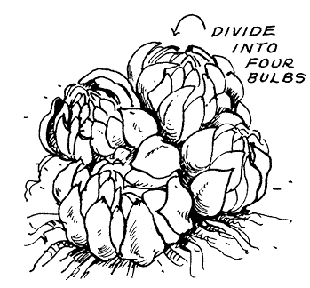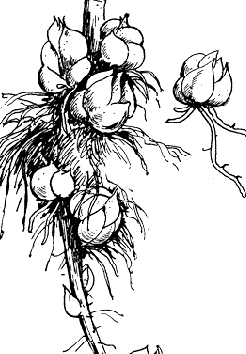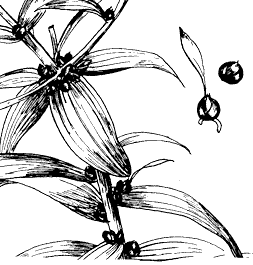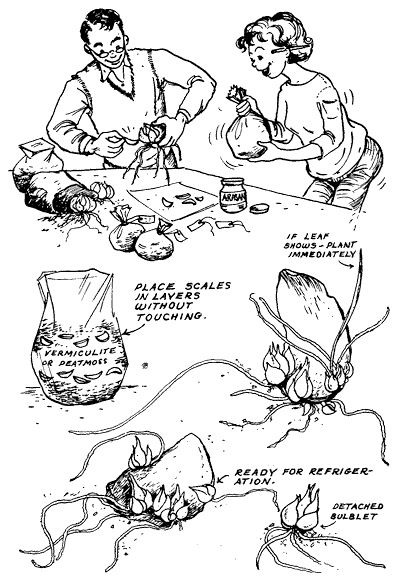Natural Division
If you just leave them alone and don’t do anything but give ordinary care, most lilies will divide regularly. Some, such as Asiatics, can make from two to four new bulbs in a year. Trumpets and Aurelians may take a little longer.
If a lily plant or group is doing well, it is considered advisable to leave it alone. There are other methods of propagation we can use. When shorter, crowded stems announce, “Time for a change,” the clump may be lifted with a fork and gently tugged apart. This is fun. It is like digging for buried treasure! Most likely you will be surprised, pleased and delighted to see how many plants you now have. Some bulbs of the rhizomatous type such as L. pardalinum may be cut apart so that each portion with a new white crown forms its own plant.
Stem Bulblets
 When you lift your lilies for dividing, you may find small bulblets, in the clump, which are often clustered along the underground part of the stem. This is another easy method of natural propagation. Stem bulblets, on varieties that produce them, will be formed every year. In the fall, you can hasten their growth to adult bulbhood by carefully detaching them with any little roots that might have been produced, and moving them to better positions around the parent plant or, better yet, into a carefully prepared nursery bed for a year or more. Don’t you have a nursery? You really should if you plan to propagate many lilies.
When you lift your lilies for dividing, you may find small bulblets, in the clump, which are often clustered along the underground part of the stem. This is another easy method of natural propagation. Stem bulblets, on varieties that produce them, will be formed every year. In the fall, you can hasten their growth to adult bulbhood by carefully detaching them with any little roots that might have been produced, and moving them to better positions around the parent plant or, better yet, into a carefully prepared nursery bed for a year or more. Don’t you have a nursery? You really should if you plan to propagate many lilies.
Baby bulblets grow so much faster and do so much better in a special little bed of friable soil where they can be watched, watered, fed and kept free from weeds and competition with adult perennials and shrubs. Be sure the bed is raised a few inches to insure good drainage. A bit of shade does no harm but avoid the roots of trees.
Bulbils
Your nursery is the place also for planting aerial bulbils. Have you seen the little black “beads” on the stems of Tiger Lilies? These are stem bulbils. A few other lilies produce these bulbils in the axils of their leaves.
If gathered when fat and ripe, these little bulbils may be planted in a furrow much like peas, and, in a year or two, produce a prodigious amount of good-sized bulbs for your garden and to share with friends.
Scales
 Naturally, you don’t want your lilies to do all the multiplying by themselves. You want to get into the act too and growing from scales will give you that chance. Most amateurs scale their lilies, especially the expensive ones, before they plant the bulbs. It does no harm to a firm fat bulb to snatch off a few scales, about four to eight, for propagation purposes. Do not be too greedy though because scales are your lily bulb’s food supply for next year. Snap off the scales close to the bulb, and dust both the bulb and scales with a fungicide. It is always good insurance to dust bulbs before planting. This way you can manage two operations with one shake of dust.
Naturally, you don’t want your lilies to do all the multiplying by themselves. You want to get into the act too and growing from scales will give you that chance. Most amateurs scale their lilies, especially the expensive ones, before they plant the bulbs. It does no harm to a firm fat bulb to snatch off a few scales, about four to eight, for propagation purposes. Do not be too greedy though because scales are your lily bulb’s food supply for next year. Snap off the scales close to the bulb, and dust both the bulb and scales with a fungicide. It is always good insurance to dust bulbs before planting. This way you can manage two operations with one shake of dust.
The scales are placed in a plastic bag of slightly damp peat moss or vermiculite, labeled, fastened, and stored at approximately 70° Fahrenheit for a few weeks. If you keep peeking at them, you will see the fascinating process of bulblet production through the polyethylene without opening the bag. Some people detach the bulblets when they have formed roots and grown to a good size. The bulblets may be planted then in pots if it is still winter or stored in separate bags of peat moss in the refrigerator while the scales may be returned for another round of incubation. Or, better, the whole scale with bulblets attached may be planted and the scale used to help nourish the baby bulbs.
Scale bulblets require 6 to 12 weeks chilling in the refrigerator, if they are not wintered outside, before making top growth. In the spring they may be planted out four inches apart in the nursery bed. In a couple of years or so they will be blooming-size bulbs.